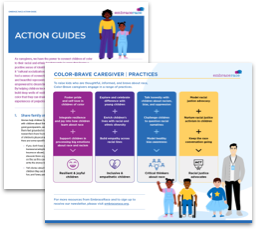3 Ways to Keep the Race Conversation Going with Kids
Racial learning is a journey, and race is a topic you should plan to revisit again and again in many different ways over time. Make race talks with your child routine, and remember that the more you practice, the better you’ll get at having those conversations. Focus on the long game of raising children who are thoughtful, informed, and brave about race. In other words: plan for a marathon, not a sprint.
It’s best to start race talk early in children’s lives, but it's ok to start anytime, anywhere. What’s important is to keep building on conversations as children grow.
Activity Ideas
-
Provide scaffolding.
Keep things simple at first, and gradually add complexity to help move children toward greater understanding of concepts. For instance, you might start out acknowledging and naming differences in skin color and facial features, move toward the idea of ‘race’ as a made-up way to categorize people, before discussing bias and discrimination and eventually structural racism (see full definitions of these terms from the American Psychological Association). Use simple and familiar concepts like kindness, fairness, and power (who has it and what is done to maintain it) to move through these ideas.
-
Continue to ask questions.
Check in with children about what they’re thinking and what they’re hearing and seeing from others. Consider all their contexts: Do they feel like they are treated fairly at school? At after school activities? How are kids treating each other at the park? What ideas do they have for making school feel more fair for more kids? What do they think about the history they’re learning in school?
-
You may not be an expert on race, but you are an expert on your child (or your classroom).
Continually reevaluate how children are digesting the information they’re receiving. Is this too much? Are they ready for more? Can they handle a 2-minute conversation or a 30-minute conversation on this topic? Would a well-chosen book help them (or help you help them) understand a certain concept?
Teaching and learning about race and racism isn’t a one-and-done deal for any of us. If you’re trying to be healthy and fit, you don’t exercise 8 hours a day for a month and then never again – you create a habit of working out or even taking a few extra steps, that, ideally, you can stick to for the long haul and build on gradually. Similarly, racial learning is most powerful when we sustain and build the effort over time.
Activity Ideas
-
Make it fun!
Anything that is totally unpleasant is not likely to be sustainable. Some topics related to racism and oppression are always going to be heavy emotionally. But a lot of racial learning can be fun! Find creative ways to integrate games, card decks, puppets, and art activities into your teaching and learning about race and fairness.
-
Reread books you found helpful.
It’s not only allowed, it’s a great idea! The more children engage with stories and images, the more they understand and take away.
-
Seek out new voices.
It’s not all on you! You don’t need to have all the answers – you can be a powerful model of learning for children by seeking out members of other communities – in person or online – and listening to their perspectives and experiences.
-
Find other people you trust who will do the work alongside you.
As Kira Banks writes, “Hard work and discomfort is easier to endure when you are in community. Find people you can be honest with, who aren’t scared to be honest with you. Giving and receiving feedback is a gift, so seek out people you want to grow with.”
We all make mistakes, especially when we’re trying to tackle big topics we’ve been trained not to talk about! Don’t expect perfection, either from yourself or your kids.
Activity Ideas
-
Allow for both curiosity and misunderstandings in children.
If little ones say something cringe-y in public, stay calm! It’s important that children aren’t made to feel guilty or ashamed for noticing or talking about race. You might feel embarrassed by a child’s words or actions, but they don’t mean you have done something wrong. They mean you’ve been given an opportunity to teach - and to learn. Remember that children inevitably pick up all kinds of messages about race from their environments. Our role is to ask them questions to understand what information they’re trying to make sense of and help them process that information, identifying what is true and untrue, in a way that promotes resilience and anti-racism.
-
There are many racial messages your children encounter in the world every day, many of them untrue.
Don't be surprised when kids say something problematic (i.e. racist) and be careful not to shame them. Instead, use it as an opportunity to help shift their thinking by gently explaining that you have a different perspective and offering it.
-
Don’t let your own mistakes paralyze you.
The point isn’t to be perfect; the point is to do better. Learn. Do better. Keep going. Repeat! It’s always ok to say “Hey, you know how we were talking about ___ before? Well, I was thinking more about it and I had another idea…” or “I think I didn’t do a great job explaining that before, let me try again…”
-
If you don’t have a good answer to a question, come back to it.
Say, “Hmm, let me think about that for a while” or “Good question! Let’s find out more about that later, okay?” And then do the research! Another great option if you don’t have the answer or the emotional bandwidth in the moment is to create a “Question Jar” where you can write down questions, hold space for them, and pick them out to talk about at a later time.
